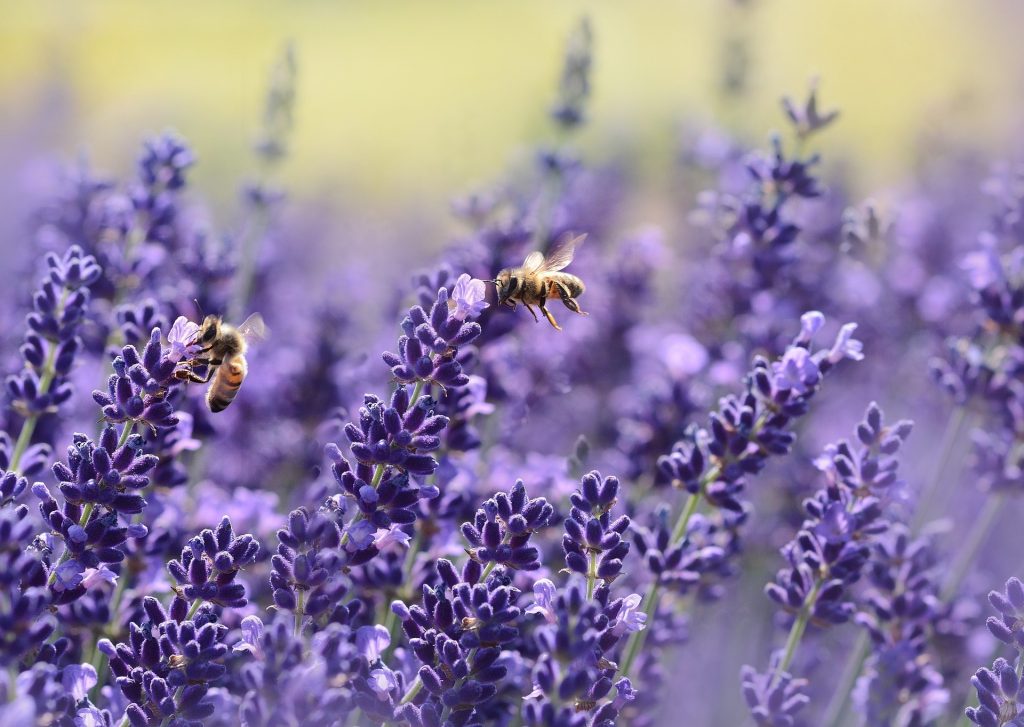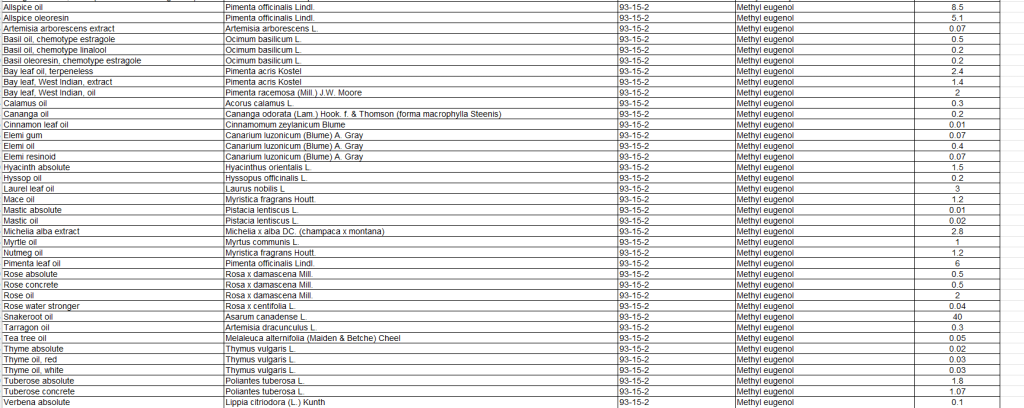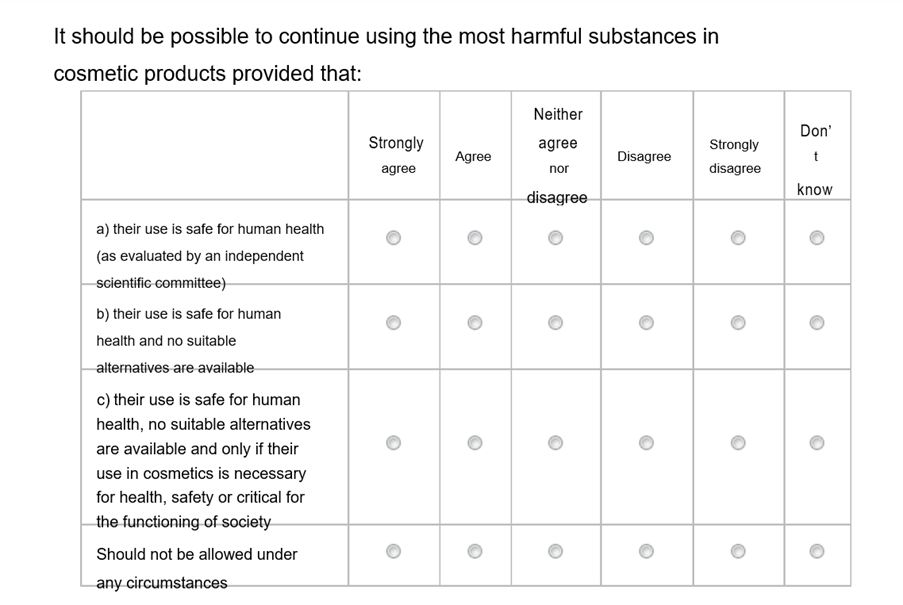Olfiction Perfumer Pia Long’s open letter to the perfume industry – a rallying call to contact EU lawmakers who are proposing legislation that threatens the usage of many natural raw materials.

You know who the largest producer of toxins is?
Nature.
Of course, we would never want to ban natural cosmetic and fragrance materials just because some natural toxins and carcinogens exist.
Or would we?
This is exactly what the unintended consequence of the EU’s well-meaning but hopelessly clumsy Green New Deal could be. Dozens of fragrance materials could become the casualty of this initiative that confuses hazard with risk.
Anyone who has conducted even the most basic risk assessment will roll their eyes at that. Why? Because anything around us could harm or even kill us, under certain circumstances. It is impossible to eliminate all risk from our lives. We can, however, come up with sensible practices that help us minimise risk.
Unfortunately, in relation to consumer product safety, the sense has left the building, as behind the scenes, ministers and lobbyists are pressuring the EU to ignore the hazard vs risk approach, and just blanket ban anything with hazardous properties, regardless of whether the product in question has been deemed safe to use as intended.
The Chemicals Strategy of EU’s Green New Deal aims to ban the most harmful chemicals in consumer products – allowing their use only where essential.1
The above is a key statement, already biased and leading (because for us to determine harm we must have context). What this means in practice is that a total ban on anything potentially carcinogenic, mutagenic, reprotoxic is being pushed, regardless of whether safe doses and use scenarios have been established. Even if potentially hazardous materials are harmless in the context of the product, that won’t matter.
Materials like lavender oil, rose oil, basil oil, and many more are therefore under threat, because the EU does not consider fragrance essential.
If you have ever wept when smelling the perfume of a dead loved one, ever felt relief when a scent has masked an anxiety-inducing malodour, ever smiled from ear-to-ear when you finally get that burst of fragrance in the shower after sweating at the gym, and millions more such everyday yet essential instances of quality-of-life improvements, I need you to pay attention. If you lost your sense of smell due to COVID-19 and felt how deep an impact that had on your life, I need you to pay attention. I need you to write to some of these decision makers and ask for them to consider what the unintended consequences of an otherwise wholesome initiative could be.
The issue here is not safety. We all agree that we want consumer products to be safe. Nobody is arguing against that. It’s the unscientific approach of this initiative that will cause a cascade of problems.
The Irony of Nature
The natural fragrance raw materials we use in perfumery are concentrated forms of what the plants produce themselves. Plants are natural chemical factories. Plant materials are natural complex chemical mixtures. Rose oil is made up of around 350 chemicals, others, a hundred, some, a couple of dozen.
Certain chemicals will contribute a great deal to the smell of the finished essential oil, absolute, Co2 extract or resin, some chemicals will be beneficial to us, and occasionally a plant material will contain something that could be harmful to us. This is why the industry trade body International Fragrance Association (IFRA) has developed a methodology along with the Research Institute of Fragrance Materials (RIFM) to research, gather and publish a set of Standards (maximum amounts of hazardous substances in the fragrance concentrate) which all professional perfumers and brands adhere to. I say all – the reality is that many independent and especially non-EU perfumers and brands do not, and this is in part driving confusion about whether consumer products are or aren’t currently safe.
When a perfumer follows the IFRA guidelines, the calculations are so complex that most individuals and companies now rely on software. If I am creating a perfume formula with 60 lines (each line representing a raw material), several of those materials themselves contain a “mini formula” of chemical constituents that I need to be aware of. By the time my fragrance is ready to be included in a product, I will be able to calculate the accumulated total of undesirable chemicals present, and make sure they fall within safe limits. By the time a product in which the fragrance was included is being examined for consumer safety, the toxicologist doing so can see exactly what trace amounts remain of undesirable materials. There is a point at which they no longer represent a risk to consumers.
Below is a small extract from the IFRA 49th Amendment in the form of screenshots from the supporting information provided to IFRA members.

Coumarin is carcinogenic.

Methyl eugenol is carcinogenic.

Estragole is carcinogenic.
In this age of social media, of tail wagging the dog, can you imagine being a brand and trying to have this conversation in public? Can you imagine what would come of trying to educate the already scared, the already misinformed, when it transpires that the product they thought would be the safest possible option for their family (something containing only natural essential oils – because marketing has made them believe that natural equals safe) turns out to contain carcinogens? How would you even begin to address the underlying issues?
Or perhaps you are a brand who has distorted science for commercial gain. In which case, part of what is happening now is on you.
Moral Purity and the Commercial Gain of Greenwashing
Imagine telling people that coffee should be banned because it contains the probable carcinogen acrylamide? Yet studies on coffee have deemed that it is not carcinogenic2. This would not be an acceptable sacrifice in the name of “just in case” public safety approach for most people.
Cosmetic products and fragrance are an easier gain for those who wish to signal to the public that “we are making your lives safer and our environment healthier”, because cosmetics manufacturers and our broader fragrance trade have been participating in their own destruction. Participated, by being too obfuscating, too insular, too keen on short-term commercial gain from jumping on various bandwagons, and not educating their own client base.
The time for business at all costs must end.
The EU’s Green New Deal will take its lead from the moral purity argument of “let’s just outright ban any trace of carcinogens from cosmetics, regardless of whether the amounts in the finished products have been deemed to be meaningless to safety.” The Precautionary Principle of eliminating things or preparing for things just in case has its place in a specific set of scenarios, say a threat of an asteroid hit. It has no place in a nuanced field where a risk assessment (and subsequent mitigation) is the appropriate approach. The EU’s Green New Deal has also been influenced by a Nordic approach to personal grooming – a disdain (not just dislike) of fragrance, and the “sauna clean” ideal of nothing but hot steam and plain soap.
Complex problems often require complex solutions.
Greedy and short-sighted manufacturers, brands and individuals have capitalised on the idea of equating “chemical” with “toxic” and “natural” with “safe.”
All matter is made up of chemicals. Chemistry is vital to life. Chemistry IS life. Our bodies produce and require chemicals. Humanity has harnessed the natural chemistry of plants since time immemorial, first by trial and error, then through more refined science – but ultimately to benefit humankind, and in the process creating entire trades.
Separating “chemical” and “natural” is a fallacy on multiple levels, and the idea that they can be separated has fed into a public sense of chemophobia. This environment does not result in better or safer products. This environment does not increase scientific literacy, it damages it. This environment does not enhance the ability for chemists to talk to the public, it poisons it.
For too long, the reality of chemical safety, consumer product safety, and environmental safety have been muddled with marketing, the morality of “purity”, and commercial interests. We must now fight greenwashing, eco-bandwagon jumping, and especially, the dangerous trajectory of moral and ideological arguments directing scientific policy.
We do Need Chemical Regulation
I am in favour of, and fully support chemical regulation. The trade I operate in (fragrance trade) fully supports chemical regulation and consumer product safety. Even if one were a completely callous businessperson only, it would be idiotic not to support the above. Chemical regulation is absolutely necessary in the multitude of cases we can all think about – toxic waste, workplace exposure, and yes – consumer product safety.
The EU’s current trajectory seems to be to excessively regulate the cosmetic and fragrance trade, using a biased, oddly unscientific approach, however.
Should the fragrance trade:
- Minimise or even eliminate where possible, exposure to carcinogenic, mutagenic and reprotoxic substances in the work environment? Yes, and it is already doing that.
- Minimise or even eliminate where possible, inclusion of carcinogenic, mutagenic and reprotoxic substances in products that fall under the cosmetics regulation? Yes, and it is already doing that.
- Ensure that the product manufacturers and brands check their products are safe? Yes, and if there is room to improve it’s here – the framework for safety assessments of cosmetics is uneven and could be harmonised further globally. But in the EU, there is a strict process in place of stability testing, safety testing and toxicologist assessment of the formula in place already.
There has been a so-called public consultation on the proposals recently. This is how the EU’s public consultation letter went out:

I asked a toxicologist friend his opinion on this document (and the question above specifically). His reply: There is misleading/biased wording of the questions. It’s simply another step down the path of regulation by potential hazard, not risk. To ask a question that says “It should be possible to continue using the most harmful substances in cosmetic products provided that:” is completely ridiculous. To say something is harmful is an exposure-based conclusion, not a hazard-based conclusion. Even the most hazardous substances are not harmful if the dose is low enough.
Fragrance is Global
This is a global issue, and it won’t be contained within the EU. Why? Growers, manufacturers, brands, suppliers – are all part of a global supply and retail scene, and if an ingredient becomes banned in a major market (and especially if it gets formulated out of global consumer brands), its manufacturing/production/growing will diminish or even disappear. Also, if one market has successfully used a political/ethical argument to get something written into law, it can affect the decision making in other countries.
You may think you will be safe from this, if you operate outside of the EU, but I implore you to take a more active role in fighting back on the nonsensical parts of EU regulations because IFRA alone can’t do it3, and if anything, IFRA gets wrongly accused of being the perpetrator (when they are the dam stopping us all from getting overwhelmed by the flood). We need much more to happen for there to be actual recognition of the foolishness of the EU’s approach. It may already be too late.
On a personal level, I feel the fragrance and cosmetic trade has been overly slow, overly corporate, and overly secretive about all of this, to its own detriment. Talking about Eurocentric heritage, making a business case – it’s not enough, and it’s not going to persuade anyone whose mentality is “why should we let anyone include a harmful substance in a product?” because the answer of “our business and livelihood would suffer” is not a sufficient. We need to challenge the premise itself, not argue based on rules that have been wrongly set.
Unless we – everyone who uses, produces, creates, manufactures, adores fragrance – acts now, many fragrance materials will be banned based on poor science. Unless we act now, there will be no case for fragrance being essential.
P.S.
No, it’s not the fragrance houses doing this. The fragrance houses rely on natural raw materials just as much as they rely on the synthetic, and any reformulations of fragrance (of which there’d be thousands if this goes through) is down to the fragrance house. A massive cost.
A Call to Action – Here is Who to Contact
Dirk Hudig
Secretary General
European Regulation and Innovation Forum
&
Max Bentinck
European Regulation and Innovation Forum
Programme Executive
Rue de la Loi 227
1040 Brussels, Belgium
Telephone: +32 2 613 2828
Fax: +32 2 613 28 49
Leonore Gewessler
Minister of Climate Action, Environment, Energy, Mobility, Innovation and Technology, Austria
Zakia Khattabi
Minister of the Climate, the Environment, Sustainable Development and Green Deal, Belgium
Lea Wermelin
Minister for Environment, Denmark
Maria Ohisalo
Minister of the Environment and Climate Change, Finland
Joëlle Welfring
Minister for the Environment, Climate and Sustainable Development, Luxembourg
Espen Barth Eide
Minister of Climate and Environment, Norway
Teresa Ribera
Minister for the Ecological Transition and the Demographic Challenge, Spain
Annika Strandhäll
Minister for Climate and the Environment, Sweden
About the Author
Pia Long is the chief perfumer and co-founder of Olfiction Limited, an independently owned UK fragrance house and consultancy. She has written extensively on the topic of perfumery and fragrance regulations, for multiple publications. She is a council member of the BSP (British Society of Perfumers) and a full member of the ISPC (International Society of Perfumer Creators).
Further organisations in the fight for a genuinely ethical trade:
https://perfumeryethics.org/
https://artandolfaction.com/
[1] https://environment.ec.europa.eu/strategy/chemicals-strategy_en
“banning the most harmful chemicals in consumer products – allowing their use only where essential”
[2] https://www.cancer.org/latest-news/coffee-and-cancer-what-the-research-really-shows.html
Coffee can contain acrylamide, a chemical that is also used in certain industrial processes and has been commercially available since the 1950s. In addition to coffee, acrylamide is also found in French fries (frying causes acrylamide formation), toasted bread, snack foods, like potato chips and pretzels, crackers, biscuits, cookies and cereals, and in tobacco products. Acrylamide is classified by IARC as a “probable carcinogen,” based primarily on genotoxicity experiments in animals. In 2002, Swedish scientists discovered that acrylamide could be formed from asparagine (an amino acid) and sugar during high-heat cooking. This discovery led to intensified research into the association between acrylamide intake from diet and cancer risk in humans. In 2011 and 2014, two large studies summarized the evidence in humans and found no association between dietary acrylamide and risk of several cancers.
[3] https://www.fragrancematters.org/
Click here to download a PDF copy of this article to share with industry colleagues.